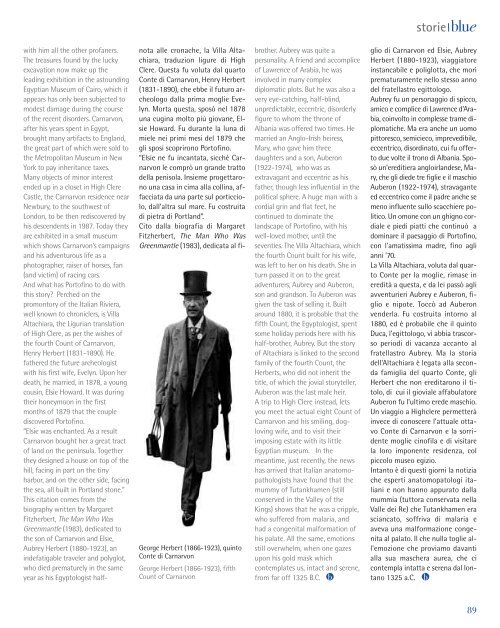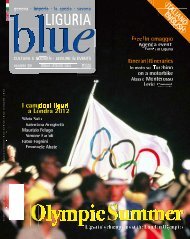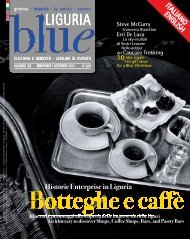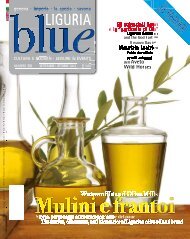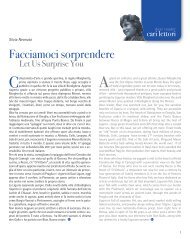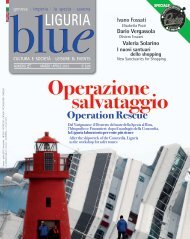You also want an ePaper? Increase the reach of your titles
YUMPU automatically turns print PDFs into web optimized ePapers that Google loves.
with him all the other profaners.<br />
The treasures found by the lucky<br />
excavation now make up the<br />
leading exhibition in the astounding<br />
Egyptian Museum of Cairo, which it<br />
appears has only been subjected to<br />
modest damage during the course<br />
of the recent disorders. Carnarvon,<br />
after his years spent in Egypt,<br />
brought many artifacts to England,<br />
the great part of which were sold to<br />
the Metropolitan Museum in New<br />
York to pay inheritance taxes.<br />
Many objects of minor interest<br />
ended up in a closet in High Clere<br />
Castle, the Carnarvon residence near<br />
Newbury, to the southwest of<br />
London, to be then redis<strong>cover</strong>ed by<br />
his descendents in 1987. Today they<br />
are exhibited in a small museum<br />
which shows Carnarvon’s campaigns<br />
and his adventurous life as a<br />
photographer, raiser of horses, fan<br />
(and victim) of racing cars.<br />
And what has Portofino to do with<br />
this story? Perched on the<br />
promontory of the Italian Riviera,<br />
well known to chroniclers, is Villa<br />
Altachiara, the <strong>Liguria</strong>n translation<br />
of High Clere, as per the wishes of<br />
the fourth Count of Carnarvon,<br />
Henry Herbert (1831-1890). He<br />
fathered the future archeologist<br />
with his first wife, Evelyn. Upon her<br />
death, he married, in 1878, a young<br />
cousin, Elsie Howard. It was during<br />
their honeymoon in the first<br />
months of 1879 that the couple<br />
dis<strong>cover</strong>ed Portofino.<br />
“Elsie was enchanted. As a result<br />
Carnarvon bought her a great tract<br />
of land on the peninsula. Together<br />
they designed a house on top of the<br />
hill, facing in part on the tiny<br />
harbor, and on the other side, facing<br />
the sea, all built in Portland stone.”<br />
This citation comes from the<br />
biography written by Margaret<br />
Fitzherbert, The Man Who Was<br />
Greenmantle (1983), dedicated to<br />
the son of Carnarvon and Elsie,<br />
Aubrey Herbert (1880-1923), an<br />
indefatigable traveler and polyglot,<br />
who died prematurely in the same<br />
year as his Egyptologist half-<br />
nota alle cronache, la Villa Altachiara,<br />
traduzion ligure di High<br />
Clere. Questa fu voluta dal quarto<br />
Conte di Carnarvon, Henry Herbert<br />
(1831-1890), che ebbe il futuro archeologo<br />
dalla prima moglie Evelyn.<br />
Morta questa, sposò nel 1878<br />
una cugina molto più giovane, Elsie<br />
Howard. Fu durante la luna di<br />
miele nei primi mesi del 1879 che<br />
gli sposi scoprirono Portofino.<br />
“Elsie ne fu incantata, sicché Carnarvon<br />
le comprò un grande tratto<br />
della penisola. Insieme progettarono<br />
una casa in cima alla collina, affacciata<br />
da una parte sul porticciolo,<br />
dall’altra sul mare. Fu costruita<br />
di pietra di Portland”.<br />
Cito dalla biografia di Margaret<br />
Fitzherbert, The Man Who Was<br />
Greenmantle (1983), dedicata al fi-<br />
George Herbert (1866-1923), quinto<br />
Conte di Carnarvon<br />
George Herbert (1866-1923), fifth<br />
Count of Carnarvon<br />
brother. Aubrey was quite a<br />
personality. A friend and accomplice<br />
of Lawrence of Arabia, he was<br />
involved in many complex<br />
diplomatic plots. But he was also a<br />
very eye-catching, half-blind,<br />
unpredictable, eccentric, disorderly<br />
figure to whom the throne of<br />
Albania was offered two times. He<br />
married an Anglo-Irish heiress,<br />
Mary, who gave him three<br />
daughters and a son, Auberon<br />
(1922-1974), who was as<br />
extravagant and eccentric as his<br />
father, though less influential in the<br />
political sphere. A huge man with a<br />
cordial grin and flat feet, he<br />
continued to dominate the<br />
landscape of Portofino, with his<br />
well-loved mother, until the<br />
seventies. The Villa Altachiara, which<br />
the fourth Count built for his wife,<br />
was left to her on his death. She in<br />
turn passed it on to the great<br />
adventurers, Aubrey and Auberon,<br />
son and grandson. To Auberon was<br />
given the task of selling it. Built<br />
around 1880, it is probable that the<br />
fifth Count, the Egyptologist, spent<br />
some holiday periods here with his<br />
half-brother, Aubrey. But the story<br />
of Altachiara is linked to the second<br />
family of the fourth Count, the<br />
Herberts, who did not inherit the<br />
title, of which the jovial storyteller,<br />
Auberon was the last male heir.<br />
A trip to High Clere instead, lets<br />
you meet the actual eight Count of<br />
Carnarvon and his smiling, dogloving<br />
wife, and to visit their<br />
imposing estate with its little<br />
Egyptian museum. In the<br />
meantime, just recently, the news<br />
has arrived that Italian anatomopathologists<br />
have found that the<br />
mummy of Tutankhamen (still<br />
conserved in the Valley of the<br />
Kings) shows that he was a cripple,<br />
who suffered from malaria, and<br />
had a congenital malformation of<br />
his palate. All the same, emotions<br />
still overwhelm, when one gazes<br />
upon his gold mask which<br />
contemplates us, intact and serene,<br />
from far off 1325 B.C.<br />
storie<br />
blue<br />
glio di Carnarvon ed Elsie, Aubrey<br />
Herbert (1880-1923), viaggiatore<br />
instancabile e poliglotta, che morì<br />
prematuramente nello stesso anno<br />
del fratellastro egittologo.<br />
Aubrey fu un personaggio di spicco,<br />
amico e complice di Lawrence d’Arabia,<br />
coinvolto in complesse trame diplomatiche.<br />
Ma era anche un uomo<br />
pittoresco, semicieco, imprevedibile,<br />
eccentrico, disordinato, cui fu offerto<br />
due volte il trono di Albania. Sposò<br />
un’ereditiera angloirlandese, Mary,<br />
che gli diede tre figlie e il maschio<br />
Auberon (1922-1974), stravagante<br />
ed eccentrico come il padre anche se<br />
meno influente sullo scacchiere politico.<br />
Un omone con un ghigno cordiale<br />
e piedi piatti che continuò a<br />
dominare il paesaggio di Portofino,<br />
con l’amatissima madre, fino agli<br />
anni ’70.<br />
La Villa Altachiara, voluta dal quarto<br />
Conte per la moglie, rimase in<br />
eredità a questa, e da lei passò agli<br />
avventurieri Aubrey e Auberon, figlio<br />
e nipote. Toccò ad Auberon<br />
venderla. Fu costruita intorno al<br />
1880, ed è probabile che il quinto<br />
Duca, l’egittologo, vi abbia trascorso<br />
periodi di vacanza accanto al<br />
fratellastro Aubrey. Ma la storia<br />
dell’Altachiara è legata alla seconda<br />
famiglia del quarto Conte, gli<br />
Herbert che non ereditarono il titolo,<br />
di cui il gioviale affabulatore<br />
Auberon fu l’ultimo erede maschio.<br />
Un viaggio a Highclere permetterà<br />
invece di conoscere l’attuale ottavo<br />
Conte di Carnarvon e la sorridente<br />
moglie cinofila e di visitare<br />
la loro imponente residenza, col<br />
piccolo museo egizio.<br />
Intanto è di questi giorni la notizia<br />
che esperti anatomopatologi italiani<br />
e non hanno appurato dalla<br />
mummia (tuttora conservata nella<br />
Valle dei Re) che Tutankhamen era<br />
sciancato, soffriva di malaria e<br />
aveva una malformazione congenita<br />
al palato. Il che nulla toglie all’emozione<br />
che proviamo davanti<br />
alla sua maschera aurea, che ci<br />
contempla intatta e serena dal lontano<br />
1325 a.C.<br />
89


